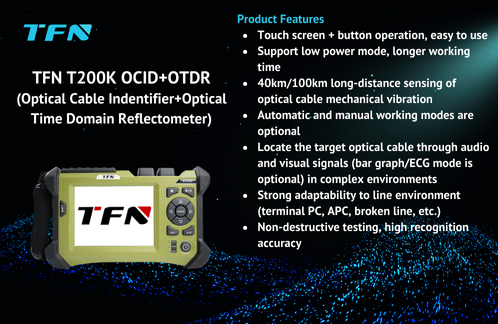How does the optical cable identifier improve the efficiency of optical fiber testing?
With the rapid development of communication networks today, the efficiency of optical fiber operation and maintenance directly affects the network quality and maintenance costs. Traditional optical cable identification methods (such as cutting, bending, and freezing) are not only time-consuming and labor-intensive, but also have the risk of damaging the optical cable. The emergence of the optical cable identifier has completely revolutionized the optical fiber testing mode. This article takes the TFN GP200 optical cable identifier as an example to analyze how it achieves a leap in efficiency.
1. Innovation principle: the technological core of non-destructive testing
The core breakthrough of the optical cable identifier lies in the use of photoelastic effect technology. When the technician knocks on the optical cable, the GP200 captures the mechanical vibration of the optical fiber through a 1550nm wavelength light source, and converts the vibration signal into a visual waveform (bar graph/electrocardiogram mode) and audio feedback in real time. This non-invasive detection method allows the identification of the target optical cable without physical destruction, fundamentally eliminating the risk of communication interruption that may be caused by traditional operations.
2. Functional integration: a multi-functional efficiency engine
GP200 series OCID tester subversively integrates the optical cable identifier and OTDR functions into one machine, with five core functional modules:
1. Ultra-long-distance survey: supports single-fiber testing, up to 100 kilometers
2. Accurate fault location: OTDR module can detect breakpoints within 40 kilometers
3. All-environment adaptability: accurate response to complex terminals such as PC/APC connectors and broken lines
4. Multimodal feedback: synchronously display vibration amplitude and ECG waveform through a 5.6-inch touch screen
5. Audio-assisted positioning: headphones receive knocking sound signals to achieve "listening to identify cables"
This integrated design allows technicians to complete the entire process of survey, distance measurement, and fault diagnosis with a single machine without carrying multiple devices.

3. Three-dimensional breakthrough in efficiency improvement
Time cost reduced by 90%
In confined scenarios such as pipeline manholes, traditional methods require several hours of section-by-section inspection. GP200 reduces the single tap response time to seconds through audio feedback. Actual cases show that an operator reduced the target optical cable identification time from 45 minutes to 3 minutes during optical cable splicing.
Human resources reduced by half
Ordinary OTDR testing requires dual-end cooperation, while the single-end testing feature of GP200 enables a single person to complete a 100-kilometer optical cable survey. Statistics from a provincial communications engineering company show that the annual maintenance labor cost has been reduced by 57%.
Full coverage of complex scenarios
Whether it is a humid tunnel environment, high-altitude operation on overhead poles, or APC connector lines, GP200 performs stably:
Anti-interference ability: adjacent optical cable crosstalk rate <0.1%
Extreme temperature adaptation: 20℃~55℃ storage temperature
Extreme battery life: 10.4Ah battery supports 10 hours of continuous operation
4. Global application scenario practice
Based on the actual sales terminal situation of the product, GP200 has created value in three major areas:
1. Resource census: Rapid file creation during the construction period of the communication operator's computer room
2. Emergency repair: Complete 1,000-kilometer fault location within 72 hours after heavy rain
3. Smart operation and maintenance: The quarterly inspection efficiency of the subway tunnel optical fiber network has increased by 80%
Actual case: In the transformation of smart street lights in a certain city, GP200 was used to complete the sorting of 120,000 core kilometers of optical cable resources within 2 weeks, which was completed 23 days ahead of schedule.
5. Long-term value: the essence of the efficiency revolution
The optical cable identifier not only improves the speed, but also reconstructs the operation and maintenance economic model:
1. Equipment cost: a single unit replaces multiple devices such as OTDR + optical power meter + light source
2. Fault loss: avoids the million-level interruption compensation caused by cutting damage
3. Life cycle: non-contact detection extends the life of the optical cable by 30%
Industry data shows that: for operators using GP200 equipment, the average annual optical cable maintenance cost has dropped by 180,000 Chinese Yuan/100 kilometers, and the fault recovery speed has entered the "minute-level" era.
Conclusion
TFN GP200 optical cable identifier solves the efficiency pain points of traditional optical fiber testing through photoelastic effect technology and multi-functional integrated design. Its single-ended operation, 100-kilometer coverage, and full-environment adaptability are redefining the standard process of communication operation and maintenance. With the acceleration of 5G and Gigabit optical network construction, such efficient tools will become the core productivity supporting digital infrastructure and promote the communication network to move towards the "zero interruption" era.
